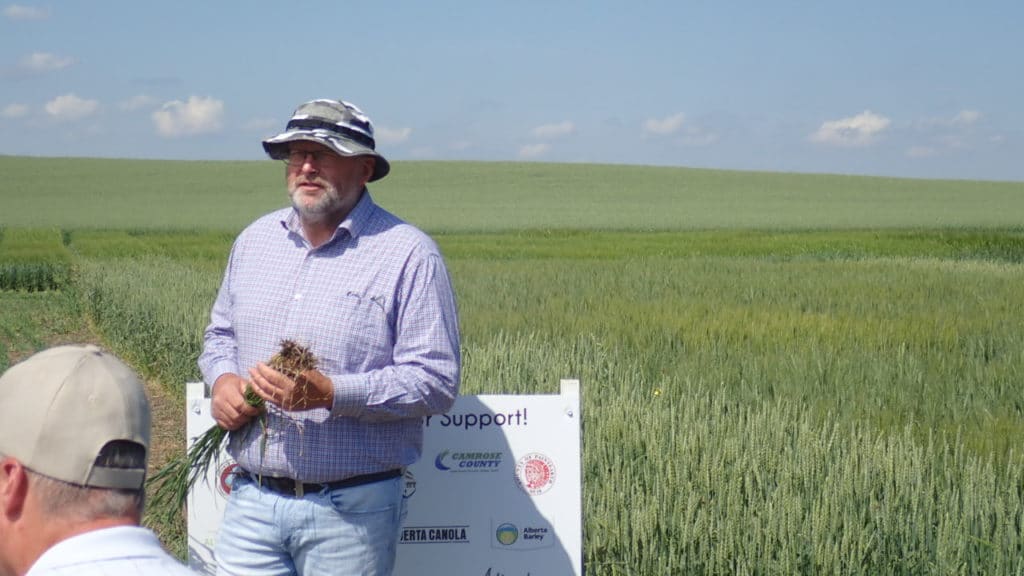PGDC works behind the scenes to make sure only the best crop varieties are brought to market.
Seed breeders may be the ones creating new crop varieties, but the Prairie Grain Development Committee (PGDC) are the ones in charge of marking sure only the best of those varieties make it into the hands of farmers.
The PGDC is made up of four independent recommending committees who are responsible for evaluating and recommending grain crop candidate cultivars for registration in Western Canada. Sheri Strydhorst, executive chairperson of PGDC, says the committees provide invaluable support to the industry as an integral part of the variety registration system in Canada, providing expertise and guidance to the Variety Registration Office (VRO) of the Canadian Food Inspection Agency (CFIA).
“This system ensures that new varieties farmers have available will maintain Canada’s reputation as a quality grain supplier and it provides protection for farmers to ensure that new varieties are equal to or better than previous varieties,” she explains.
The four independent recommending committees are:
- The Prairie Recommending Committee for Wheat, Rye and Triticale (PRCWRT)
- Prairie Recommending Committee for Oat and Barley (PRCOB)
- Prairie Recommending Committee for Pulse and Special Crops (PRCPSC)
- Prairie Recommending Committee for Oilseeds (PRCO)
The committee members are made up of industry experts representing farmers, breeding companies, seed growers, university and government institutions, industry associations, processors and downstream sales and marketing professionals.
Required to Register
The Canadian Seeds Act and Seeds Regulations require cultivars to be registered prior to seed sale in Canada and prior to import into the country. PGDC helps with this registration process by advising CFIA’s variety registration office.
“It provides a very unique opportunity to facilitate scientific discussion and communication related to the development of improved cultivars and associated research priorities,” Kelly Turkington, plant pathologist at the Lacombe Research and Development Centre, Agriculture and Agri-Food Canada, and PRCOB chair, explains.
The key to this process is providing a non-biased review of the candidates’ performance across the three western Prairie provinces using registration trials, says Glen Hawkins, a senior agronomist and pulse research manager for DL Seeds Inc.
“Each candidate species has a set of registration guidelines that sets out how the candidate will be grown, what data will be assessed, how many years it needs to be tested for and what merits are evaluated,” he explains.
The evaluated merits from these trials are then voted on first by the evaluation subcommittees and then by the entire voting body of the general committee. The general committee will then provide a recommendation for variety registration to the VRO and the CFIA for cultivation in Western Canada.
“We are constantly evolving what we assess for merit and adapting to the needs of farmers and users. Moving the bar for agronomic characters, adding resistances to disease and quality are all areas that are assessed and changed on an ongoing basis,” Hawkins says.
Supporting Structure
Each recommending committee is comprised of various evaluation teams, who bring their areas of expertise to the process.
“The evaluation teams are responsible for defining merit, determining testing and evaluation protocols, and assessing the merit for agronomic performance, disease and pest resistance and end-use quality, such as milling, protein quality and quantity, enzymes, and end-use products,” Strydhorst says. Adding all full numbers of PGDC are members of one of the evaluation teams.
The evaluation teams:
- Agronomic Evaluation Team (AET)
- Disease Evaluation Team (DET)
- Quality Evaluation Team (QET)
- Cultivar Voting Panel (CVP) for the PRCWRT
Each variety or cultivar is carefully compared and must be equal to or better than the check for — grain yield, maturity, lodging, test weight, and winter survival, when applicable. The acceptable limits beyond the poorest check are calculated, resulting in the line being labeled as endorsed or requiring discussion by PGDC.
For the PRCWRT, testing of individual varietal lines normally takes three consecutive years, using an approved set of sites across a broad range of climate and soil types in the area of expected commercial production.
“A standard of eight sites of acceptable grain yield data per year, for a total of at least 24 site-years, collected over three years or more are required prior to a candidate cultivar being considered for merit assessment,” Strydhorst says.
Through the Years
This work isn’t new, but it’s becoming even more important as pressures mount to increase production and decrease inputs while feeding a growing global population.
The current PGDC came into effect in 2006-2007 replacing the previous organization — the Prairie Registration and Recommending Committee for Grains (PRRCG). PRRCG was founded in 1989, with the Expert Committee on Grains (ECG) in charge of the reviewing and approval process before. In 1986 ECG split into eastern and western divisions.

Kelly Turkington, plant pathologist at the Lacombe Research and Development Centre, Agriculture and Agri-Food Canada
“Issues in central Canada and the Prairies can be different and thus the move to separate committees for the prairies and central Canada and the Maritimes. Other issues may be in terms of the ability to incorporate more input and participation by a range of stakeholders across the variety improvement continuum,” Turkington explains.
For the Future
In 2021, 17 new wheat and triticale cultivars were recommended for registration at the PGDC meeting — slightly fewer than were recommended in previous years.
PRCOB supported 10 new lines. Pulses and special crops recommended 18 lines, which Hawkins said was on the low side of normal. There were no lines recommended for oilseeds, which PRCO Chairman Wayne Thompson says is normal.
“We do not expect them to release a variety every year. The production area for both crops do not support the ability to release a new variety each year,” he explains. “At the moment we have one mustard breeding program and one flax breeding program.”
Turkington expects PGDC will stay quite busy, as breeders from seed companies and public breeding institutions work to address changing markets and adapt current priorities.
“It is an ongoing process, but often we are seeing recommended candidate lines that have superior yield and quality characteristics that are combined with better disease resistance packages,” Turkington says. “From strictly a plant pathology point of view there are concerns that the importance of disease resistance will decrease, potentially leading to increasing disease risks.”
The PGDC plays a crucial role in this process, bringing the interested parties together to discuss and recommend lines to become varieties.
“It provides a venue for the assessment of lines to ensure that new varieties be an improvement from current varieties available to farmers and the industry,” Thompson says.
Without the committees, farmers would have to make decisions on new varieties based on data from representing companies. Thompson says this is possible, but farmers would have to determine what’s best for their farms without an unbiased independent information source to use.
Turkington believes PGDC and the committees themselves will continue to evolve as needs change. That’s the purpose of the group, and what allows for its success with the industry.
PGDC provides critical support of the Canadian seed industry, and Hawkins says conversations with farmers over past years have revealed to him that farmers’ have trust in PGDC’s procedures.
“They see it as a safety net of sorts that ensures that new varieties coming to market have been tested and are adapted to Western Canada,” he says.
And with seeds as the start to any crop, the PGDC and the structure which runs it are the base of crops across the Prairies.
Related Articles
Striving Forward for FCDC at its New Home at Olds College







